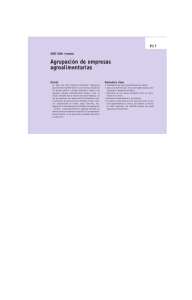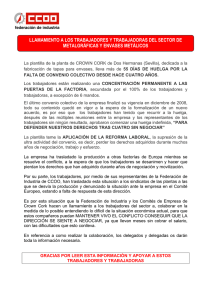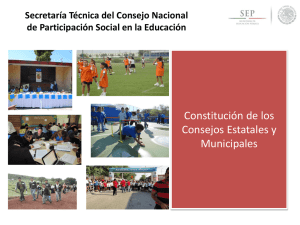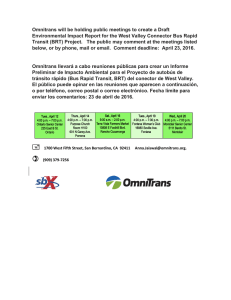West Cork Arts Centre West Cork Arts Centre was established in
Anuncio
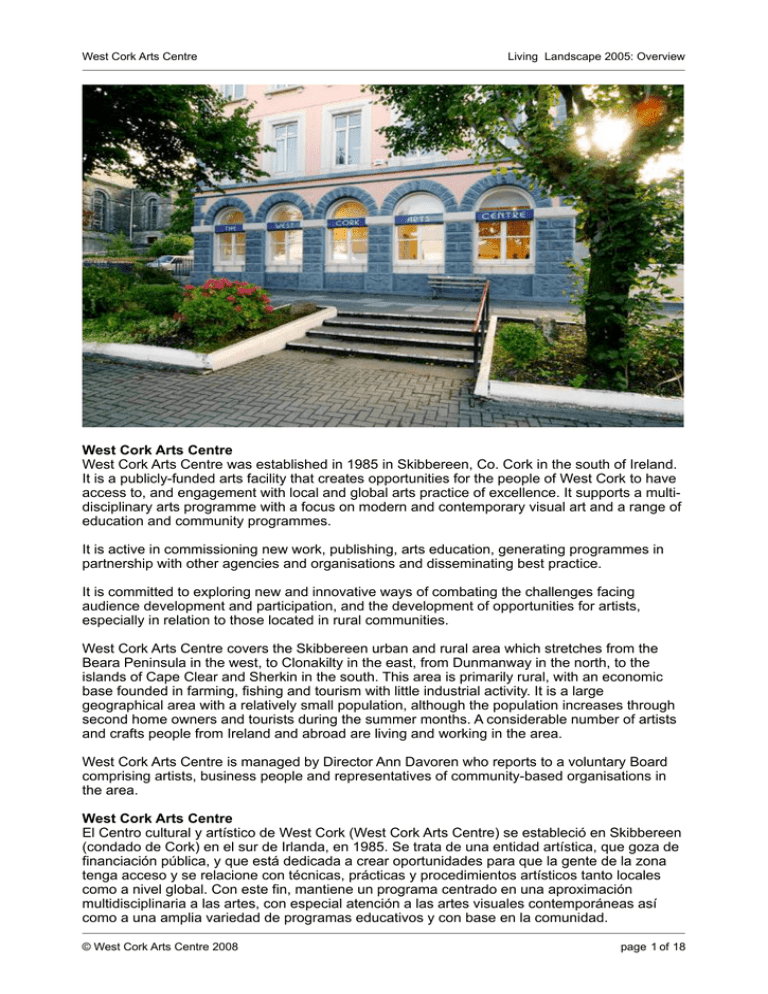
West Cork Arts Centre
Living Landscape 2005: Overview
West Cork Arts Centre
West Cork Arts Centre was established in 1985 in Skibbereen, Co. Cork in the south of Ireland.
It is a publicly-funded arts facility that creates opportunities for the people of West Cork to have
access to, and engagement with local and global arts practice of excellence. It supports a multidisciplinary arts programme with a focus on modern and contemporary visual art and a range of
education and community programmes.
It is active in commissioning new work, publishing, arts education, generating programmes in
partnership with other agencies and organisations and disseminating best practice.
It is committed to exploring new and innovative ways of combating the challenges facing
audience development and participation, and the development of opportunities for artists,
especially in relation to those located in rural communities.
West Cork Arts Centre covers the Skibbereen urban and rural area which stretches from the
Beara Peninsula in the west, to Clonakilty in the east, from Dunmanway in the north, to the
islands of Cape Clear and Sherkin in the south. This area is primarily rural, with an economic
base founded in farming, fishing and tourism with little industrial activity. It is a large
geographical area with a relatively small population, although the population increases through
second home owners and tourists during the summer months. A considerable number of artists
and crafts people from Ireland and abroad are living and working in the area.
West Cork Arts Centre is managed by Director Ann Davoren who reports to a voluntary Board
comprising artists, business people and representatives of community-based organisations in
the area.
West Cork Arts Centre
El Centro cultural y artístico de West Cork (West Cork Arts Centre) se estableció en Skibbereen
(condado de Cork) en el sur de Irlanda, en 1985. Se trata de una entidad artística, que goza de
financiación pública, y que está dedicada a crear oportunidades para que la gente de la zona
tenga acceso y se relacione con técnicas, prácticas y procedimientos artísticos tanto locales
como a nivel global. Con este fin, mantiene un programa centrado en una aproximación
multidisciplinaria a las artes, con especial atención a las artes visuales contemporáneas así
como a una amplia variedad de programas educativos y con base en la comunidad.
© West Cork Arts Centre 2008
page 1 of 18
West Cork Arts Centre
Living Landscape 2005: Overview
El Centro participa activamente en la vida artística de la zona a través de encargos de nuevos
trabajos, publicaciones, educación artística y a través de la producción de programas en
asociación con otras agencias y organizaciones, y de la divulgación de modelos y prácticas
para el trabajo artístico.
El Centro mantiene un compromiso con la
investigación de formas nuevas e
innovadoras para combatir los problemas
y obstáculos que se presentan a la hora
del desarrollo y participación de una
audiencia, el compromiso se extiende
igualmente al desarrollo de oportunidades
para artistas, centrándose especialmente
en los artistas dentro de las comunidades
rurales.
El West Cork Arts Centre cubre el área
urbana y rural de Skibbereen, que se
extiende desde la península de Beara al
oeste, hasta Clonakilty al este, desde
Dunmanway al norte, hasta las islas de
Cape Clear y Sherkin al sur. Ésta es sobre
todo una zona rural, con una economía basada en la agricultura, la pesca y el turismo y con
escasa actividad industrial. Se trata de una extensa área geográfica con una población
relativamente pequeña, que de todas formas se ve incrementada durante los meses de verano
por la afluencia de turistas y de gente con casas para vacaciones en la zona. Existe un
considerable número de artistas y artesanos, tanto irlandeses como de fuera de Irlanda, que
viven y trabajan en la zona.
© West Cork Arts Centre 2008
page 2 of 18
West Cork Arts Centre
Living Landscape 2005: Overview
El West Cork Arts Centre está gestionado por su directora Ann Davoren, que se reúne
periódicamente con una junta que consta de voluntarios: artistas, gente de negocios y
representantes de organizaciones con base en la comunidad de la zona.
Anita Groener and Ignacio Uriarte at WCAC
Living Landscape: Ireland and Catalunya-Spain
Living Landscape: Ireland and Catalunya-Spain is an Exhibition and Symposium which took
place in West Cork in April 2005 and is planned for Barcelona in 2007. Organised by West Cork
Arts Centre (WCAC) and Sculptor's Society of Ireland (SSI), and curated by artist Therry Rudin,
the project is an exploration of contemporary artists’ relationship with and investigation of
landscape, place, environment and space. Living Landscape involves eight artists from Ireland Amanda Coogan, Anita Groener, Katie Lincoln, Patricia McKenna, FX Murphy, Sinéad Ní
Mhaonaigh, Alannah O’Kelly and Niamh O’Malley and seven from Catalunya-Spain - Chema
Alvargonzalez, Clarissa Cestari, Domènec, Jorge Satorre, Jordi Gispert, Maïs and Ignacio
Uriarte.
A number of these artists were invited to spend two weeks working in different locations in West
Cork, stretching from Skibbereen, to the near-by islands of Sherkin and Heir and west along the
coastline to Castletownbere on the Beara Peninsula. This Symposium, leading to site-specific
installation, projection and performance, further amplified the concept of ‘living landscape’ in a
European context, explored through the exhibitions at WCAC and other locations in the region
including the SW Gallery in Castletownbere.
© West Cork Arts Centre 2008
page 3 of 18
West Cork Arts Centre
Living Landscape 2005: Overview
FX Murphy on his journey to Beal na mBláth
"El Paisaje Vivo" es un proyecto que se llevó a cabo en Abril de 2005 en West Cork (Cork
Oeste) y que se realizará en Barcelona en 2007, se trata de una exposición y un simposio
organizados por el Centro de Arte de West Cork (West Cork Arts Centre) y la Sociedad de
Escultores de Irlanda (Sculptor’s Society of Ireland) y coordinado por el artista Therry Rudin. El
proyecto es una exploración de la relación del artista contemporáneo con el paisaje, el lugar, el
entorno y el espacio, y de su investigación sobre estos temas. "El Paisaje Vivo" reúne a ocho
artistas irlandeses: Amanda Coogan, Anita Groener, Katie Lincoln, Patricia McKenna, Fergus
Murphy, Sinéad Ní Mhaonaigh, Alannah O'Kelly y Niamh O'Malley, y a siete artistas
procedentes de Catalunya-España: Chema Alvargonzalez, Clarissa Cestari, Domènec, Jorge
Satorre, Jordi Gispert, Maïs e Ignacio Uriarte.
© West Cork Arts Centre 2008
page 4 of 18
West Cork Arts Centre
Living Landscape 2005: Overview
Domenec’s site specific work for Sherkin Ferry at the Baltimore Regatta
Algunos de estos artistas han sido invitados a permanecer dos semanas en diversos lugares de
West Cork, desde el pueblo de Skibbereen y las islas Sherkin y Heir, y hacia el oeste a lo largo
de la costa, hasta el pueblo de Castletownbere en la Península de Beara. El simposio, que
sirve de punto de partida para la realización de instalaciones, proyecciones y performances
especificas para cada lugar, tiene como objetivo la ampliación a un contexto europeo del
concepto de “paisaje vivo” explorado en las exposiciones en el West Cork Arts Centre y otras
instalaciones de la región, incluida la SW Gallery en Castletownbere.
Skibbereen
Skibbereen is a typical West Cork market town. From the Observation Point, the town can be
seen in the valley between the Caol Stream and the Ilen River and spreading up to the
surrounding hills. The tidal Ilen River ('the glittering water') was, up to recent times, a central
route between the islands of Roaring Water Bay and beyond to Skibbereen, when people
travelled up river by boat to trade and purchase supplies and have cereal ground in the Steam
Mill. The ‘New Bridge’, so called – it was built in 1862 – is a fine stone edifice with five arches.
Skibbereen and environs suffered devastation in the Great Famine (1846 - 1850). The
population halved and in the graveyard at Abbeystrowry Church is a plot where some 9,000
famine dead were buried. Skibbereen is said to be founded by English settlers who came inland
up the river from Baltimore after Algerian pirates raided that coastal town in 1631 and carried off
110 of their number.
Skibbereen este es un típico “pueblo mercado” de West Cork. Desde su Punto de Observación
se puede ver su disposición, en el valle entre el arroyo Caol y el Río Ilen extendiéndose a los
montes aledaños. El Ilen (el nombre significa agua brillante) es un río cuyo nivel sube y baja
con las mareas, hasta hace poco fue ruta fluvial entre las islas que se encuentran en Roaring
Water Bay (la bahía " de aguas rugientes") y Skibbereen. Por esta ruta, río arriba, navegaban
los habitantes de la zona para comerciar y realizar trueques y compras de víveres, y para llevar
cereales al molino de vapor de la población. El Puente Nuevo (New Bridge) construido en 1862,
es un bello ejemplar de puente de piedra con 5 ojos.
Skibbereen y sus alrededores sufrieron de forma devastadora los efectos de la Gran Hambruna
(Great Famine) de 1846-1850, durante la que murió la mitad de la población de la zona. En el
cementerio de la Iglesia de Abbeystrowry se encuentra una fosa con los restos de unas 9.000
víctimas de la Hambruna. Al parecer, Skibbereen fue fundado por colonos Ingleses que
© West Cork Arts Centre 2008
page 5 of 18
West Cork Arts Centre
Living Landscape 2005: Overview
escaparon, río arriba desde Baltimore, tras un ataque por piratas argelinos que secuestraron
110 de sus habitantes en 1631.
Clarissa Cestari at WCAC
Four of the artists, Clarissa Cestari, Anita Groener, Sinéad Ní Mhaonaigh and Ignacio Uriarte,
were located at WCAC in Skibbereen. The subject matter of Clarissa Cestari’s large diptychs
is essentially the physicality of the paint itself. However they refer to aspects of landscape
through their intense colour, ridged textures and subtle ever-changing surfaces. Anita Groener
has been focussing on the image and the idea of ‘road’ in her paintings and video-work for the
past two years. In this work, the road itself has become the landscape and the journey has
become the destination.
Sinéad Ní Mhaonaigh
In Sinéad Ní Mhaonaigh’s paintings and drawings, a human presence is suggested but always
absent. We encounter a no-man’s land, an apparently empty but yet intensely emotional space.
Ignacio Uriarte works with materials and processes from offices, like photographic paper and
software like Excel. One artwork consisted of 2,000 sheets of A4 paper rolled up to make a
topographic landscape. He also collaborated with the staff of the near-by library to make 3
© West Cork Arts Centre 2008
page 6 of 18
West Cork Arts Centre
Living Landscape 2005: Overview
pieces using the actions and processes that are
commonplace among office staff the world over.
FX Murphy walked from Skibbereen to Béal na
mBláth - the site of ambush where the Irish
revolutionary Michael Collins died. He pulled a
carriage constructed of elements from an army
tank, the Four Courts building in Dublin and a
limousine
Niamh O’Malley’s work stems from an ongoing
investigation into the representation of nature
through the culturally constructed idea of
landscape. Her new painting projection work,
located at Working Artists Studios, Skibbereen,
responds to the Skibbereen environment and
deals with the landscape as a normal, even
mundane, aspect to daily working life.
Jorge Satorre’s project, Windows Blowing Out
is based on an event carried out in 1976 by
Gordon Matta Clark entitled Windows Blow Out.
The action took place on a farm outside Skibbereen. His second project Barry’s Van took place
on Sherkin Island.
Documents of Jorge Satorre’s projects at WCAC
Cuatro de los artistas: Clarissa Cestari, Anita Groener, Sinéad Ní Mhaonaigh e Ignacio Uriarte,
situaron su base en el West Cork Arts Centre en Skibbereen. El tema principal de los grandes
dípticos de Clarissa Cestari es esencialmente la realidad física de la pintura misma. De todas
formas sus obras se conectan con aspectos del paisaje a través de la intensidad del color, la
rugosidad de las texturas, y los constantes y sutiles cambios en las superficies.
© West Cork Arts Centre 2008
page 7 of 18
West Cork Arts Centre
Living Landscape 2005: Overview
Voyage by Anita Groener at WCAC
El trabajo de Anita Groener se ha centrado en la imagen y la idea del ‘camino’ en sus pinturas
y trabajos de vídeo en los últimos dos años. En estas obras, el camino se ha convertido en el
paisaje y el viaje es el destino. En las pinturas y dibujos de Sinéad Ní Mhaonaigh, la presencia
humana aparece sugerida pero se encuentra siempre ausente. Sus obras nos sitúan frente a
un paisaje de tierra de nadie, un espacio vacío en apariencia cargado sin embargo de gran
intensidad emocional. Ignacio Uriarte trabaja con materiales y procesos empleados en el
trabajo de oficina, como papel fotográfico y software como Excel. Uno de sus trabajos consistió
en 2.000 hojas de papel A4 enrollado para construir un paisaje topográfico. Igualmente el
artista colaboró con el personal de la biblioteca cercana al Centro para realizar 3 obras
utilizando acciones y procesos que son parte de la rutina de la gente que trabaja como
personal de oficina en todo el mundo.
FX Murphy realizó a píe el camino entre Skibbereen y Béal na Bláth, el lugar en el que se
produjo la emboscada en la que murió el revolucionario irlandés Michael Collins. A través de
esta ruta fue tirando de un carro construido con elementos procedentes de un tanque de
guerra, del edificio de los juzgados centrales en Dublín "The Four Courts" y de una limusina
© West Cork Arts Centre 2008
page 8 of 18
West Cork Arts Centre
Living Landscape 2005: Overview
North Street, Skibbereen by Niamh O’Malley, a painting and projection installation
La obra de Niamh O’Malley surge de una investigación en curso sobre la representación de la
naturaleza a través de la idea cultural (creada) de paisaje. Su nuevo proyecto, situado en los
estudios Working Artists, Skibbereen, responde al entorno de Skibbereen y trata del paisaje
como un aspecto más, normal e incluso rutinario, de la vida diaria.
El proyecto de Jorge Satorre, Windows Blowing Out (rompiendo ventanas) se basa en un
evento que Gordon Matta Clark llevó a cabo en 1976 titulado Windows Blow Out (rotura de
ventanas). La acción se llevó a cabo en una granja en las afueras de Skibbereen. Su segundo
proyecto Barry’s Van (la furgoneta de Barry) tuvo lugar en la isla de Sherkin
Baltimore
Baltimore is a small coastal village, situated 13kms south-west of Skibbereen. Baltimore is a
busy fishing port and is the base for the southernmost RNLI lifeboat in Ireland. It is also the port
for ferries to Sherkin and Cape Clear throughout the year.
The name, Baile an Tí Mor, the 'town of the big house' probably refers to the O'Driscoll Castle,
Dún na Séad, a traditional Irish tower house with 17th century refinements which towers over the
village and is a reminder of the once powerful O'Driscoll clan who controlled much of the South
West for a number of centuries. Spain Tower to the south-east was another O'Driscoll
stronghold. After the Great Famine devastated Baltimore in the 1840s, a navigation school and
boat building industry were set up by clergy and the gentry to assist in the recovery of the town.
Salting and exporting mackerel was an industry of the entire West Cork coast in the late 1800s.
It is said that in the early 1900s, some sixteen trainloads a day of fish left Baltimore for Cork to
be exported to America.
The 17th century navigational Beacon at the entrance to Baltimore Harbour is the image most
often associated with the village. Positioned high above the channel between the mainland and
© West Cork Arts Centre 2008
page 9 of 18
West Cork Arts Centre
Living Landscape 2005: Overview
Sherkin Island, it marks the mouth of the harbour and offers spectacular views towards Sherkin,
Cape Clear, the harbour and the mouth of the Ilen River.
Domenec Here / Nowhere at the Wooden Boat Festival, Baltimore
Baltimore es un pequeño pueblo costero con un activo puerto pesquero, situado a 13
kilómetros al suroeste de Skibbereen. Es también la base del servicio de rescate marino más
meridional de Irlanda, y puerto para los transbordadores a las islas de Sherkin y Cape Clear
durante todo el año.
Su nombre derivado de Baile an Tí Mor, “pueblo de la gran casa”, hace referencia con toda
probabilidad al Castillo O’Driscoll (Dún na Séad), una casa-torre irlandesa con mejoras del siglo
XVII, que se alza sobre el paisaje del pueblo. Este castillo es parte del legado del poderoso
Clan O’Driscoll, que controló gran parte del suroeste del país durante varios siglos. La Torre
España (Spain Tower), al sureste del puerto, era otra fortaleza O’Driscoll.
Tras los efectos devastadores de la Gran Hambruna en Baltimore, en 1840 la pequeña
aristocracia local y los religiosos de la zona fundaron una escuela de navegación y un astillero,
para asistir en la recuperación de la zona. En la segunda mitad del siglo XIX, la industria de
salazón y exportación de caballa, adquirió gran auge en West Cork. Se dice que a principios de
1900, 16 trenes llenos de pescado salían diariamente de Baltimore a Cork con destino a la
exportación a América.
"The Beacon" una baliza de navegación, construida en el siglo XVII a la entrada de puerto, es
la imagen más asociada con Baltimore. Situada en alto en la entrada del canal que separa
tierra firme de la isla de Sherkin, ofrece un paisaje espectacular con vistas de las islas de
Sherkin y Cape Clear, y del puerto y la desembocadura del Río Ilen.
Alanna O’Kelly’s performance explored the legacy of Baltimore Industrial School and themes
such as isolation, loss, grief and the richness of memory and communal identity. She included a
© West Cork Arts Centre 2008
page 10 of 18
West Cork Arts Centre
Living Landscape 2005: Overview
young boy, representing the boys of the Industrial School and the concept of the Beacon Child
in the performance.
Domènec researched literary references to Ireland through the works of Beckett and Joyce and
worked with the local community to create two new site-specific installations for the Sherkin and
Heir Island ferry boats.
La performance de Alanna O’Kelly exploraba el legado de la Industrial School de Baltimore
(N. T.: Las "Industrial Schools" irlandesas eran instituciones fundadas con la idea de albergar a
niños procedentes de situaciones familiares y/o sociales problemáticas. En los últimos años,
han sido motivo de polémica debido a las revelaciones de abusos de todo tipo en un número
importante de ellas), y temas como el aislamiento, el sentimiento de pérdida, la pena y angustia
así como la riqueza que se encuentra en la memoria y en la identidad de una comunidad. En la
performance, la artista incluyó a un niño que representa a todos los niños de las Industrial
Schools, y el concepto del "niño baliza" (Beacon Child).
Domènec investigó las referencias literarias relativas a Irlanda en la obra de Beckett y Joyce, y
trabajó con la comunidad local en dos instalaciones especificas para el lugar, en los
transbordadores de las islas Sherkin y Heir
Sherkin.
Sherkin Island, with a population 120, lies less that ten minutes by ferry from Baltimore. The
island has over 8 kms of road and is ideal for cycling and walking. The island boasts a variety of
landscape – panoramic Atlantic views from the hilltops, fuchsia byways and, on the western
shores, the fine sandy beaches - Trá Ban, Trá Eoghan Mor and Silver Strand.
There is evidence of Ireland’s Danish heritage in the place names e.g. the townland of Kilmoon
and the island’s church – St. Mona. Sherkin is the ancestral home of the O’ Driscoll clan who
built Dún na Long (Fort of the ships), now in ruins. The Abbey, close to the pier, was built by
Franciscan Monks in the 15th century and is a fine example of medieval monastic architecture.
Sherkin comes from Inis Arcain ie island of the sea-porpoise.
© West Cork Arts Centre 2008
page 11 of 18
West Cork Arts Centre
Living Landscape 2005: Overview
Maïs, Sherkin Island
La Isla de Sherkin (Sherkin Island), con 120 residentes, se encuentra a diez minutos de
Baltimore por transbordador. La isla tiene mas de 8 kilómetros de carretera, y es ideal para
caminar o para andar en bicicleta. Sherkin es famosa por, entre otras cosas, su gran variedad
de paisajes: vistas del Atlántico desde sus puntos más altos, caminos cubiertos de fucsias, y,
en la costa oeste de la isla, bellas playas de arenas limpias: Trá Ban, Trá Eoghan Mor y Silver
Strand ("playa de plata")
En la isla se encuentran algunas evidencias de la influencia Danesa en nombres de lugares
como la aldea de Kilmoon, y la iglesia de San Mona. Sherkin es hogar ancestral del Clan
O’Driscoll, que construyó a Dún na Long ("el fuerte de los barcos"), hoy en ruinas. La abadía,
que se encuentra cerca del muelle, fue construida por monjes franciscanos en el siglo XV y es
un magnífico ejemplo de arquitectura monástica medieval. El nombre de Sherkin se deriva de
Inis Arcain, “la isla de la marsopa”.
Performance is at the heart of Amanda Coogan's art, and her powerful live events often form
the basis for her videos and photographs. On Sherkin Island, Amanda developed a new video
piece which was presented in an old sea-side coffee shop beside the Silver Strand.
Chema Alvargonzalez works principally in dialogue between light, words and forms and
presented a projection installation in the Abbey on Sherkin Island currently being restored by the
Office of Public Works (OPW).
Maïs created 5 permanent metal sculptures representing famous women artists for Sherkin
Island and 2 representing famous women writers for Heir Island. The artist worked closely with
the Island communities and has donated the sculptures to the islands.
© West Cork Arts Centre 2008
page 12 of 18
West Cork Arts Centre
Living Landscape 2005: Overview
Maïs, Sherkin Island
La actuación (performance) se encuentra en la esencia del arte de Amanda Coogan y sus
eventos reales en directo, poseen una gran fuerza y sirven de base para sus vídeos y
fotografías. En la isla de Sherkin, Amanda desarrolló un nuevo vídeo que se presentó en un
viejo café a la orilla del mar junto a la playa de Silver Strand.
Chema Alvargonzalez trabaja sobre todo en el diálogo entre la luz, las palabras y las formas, y
presentó una instalación con proyección en la Abadía de la isla de Sherkin, que está siendo
restaurada por la Office of Public Works (oficina de obras públicas).
Maïs creó 5 esculturas metálicas de mujeres artistas famosas para la isla de Sherkin y de
escritoras famosas para la isla de Heir. Maïs trabajó en contacto con las comunidades de
Sherkin y Heir y donó las esculturas a las islas.
© West Cork Arts Centre 2008
page 13 of 18
West Cork Arts Centre
Living Landscape 2005: Overview
Chema Alvargonzalez’s light and sound installation for Sherkin Abbey, Sherkin
Heir Island
Heir Island is 381 acres in area and has a population of about thirty people. Historically the
island formed part of the O'Driscoll Clan's territory and it is believed that one of the O'Driscoll
castles was sited at the most westerly point of the island. The landscape is low-lying and the
centre of the island has an extensive marsh with a vibrant reed bed.
La Isla de Heir tiene una superficie de unos 381 acres , con una población de unas treinta
personas. Históricamente, la isla formó parte del territorio del Clan O’Driscoll, y se cree que el
clan tenía un castillo en el punto más occidental de la isla. El paisaje tiene poco relieve con una
zona pantanosa en el centro un frondoso lecho de juncos.
© West Cork Arts Centre 2008
page 14 of 18
West Cork Arts Centre
Living Landscape 2005: Overview
Katie Lincoln worked on a film projection exploring the shifting and changing light of Heir
Island. The work was presented in an old cabin on the island that is now used as a storage
shed.
Katie Lincoln’s projection installation in an old cabin on Heir Island
Katie Lincoln trabajo en una proyección cinematográfica que exploró los cambios de la luz en
Heir Island. El trabajo se presentó en una vieja cabaña en la isla que se utiliza ahora como
almacén.
The Beara Peninsula
The Beara Peninsula is rich in sites of historical and archaeological interest, from wedge tombs
that are thousands of years old, to church sites of more recent origin. Castletownbere is the
principle town on the Beara peninsula and it is the largest whitefish port in Ireland. Berehaven is
© West Cork Arts Centre 2008
page 15 of 18
West Cork Arts Centre
Living Landscape 2005: Overview
the second largest natural harbour in the world, providing safe anchorage for fishing vessels
and pleasure craft and is ideal for watersports, Just outside Castletownbere at Dunboy, the ruins
of the O’Sullivan Beare Castle (destroyed in 1602) can be seen alongside the ruins of Puxley's
Manor ,which was owned by an English copper mining family who developed the copper mines
of Allihies near the tip of the Beara Peninsula. Cornish workers were brought over in the 19th
Century as technical experts and some remains of their 'Cornish Village' can still be seen, as
can the remains of the two pump houses for the mines.
La península de Beara
La península de Beara posee gran cantidad de lugares de interés histórico y arqueológico,
desde tumbas megalíticas de miles de años de antigüedad, hasta iglesias de más reciente
construcción. Castletownbere es el pueblo más importante de la península de Beara y es el
mayor puerto pesquero de pescado blanco de Irlanda. Berehaven es el segundo puerto natural
más grande del mundo, y proporciona refugio a barcos de pesca y embarcaciones de ocio, así
como un escenario ideal para la práctica de los deportes acuáticos. En las afueras de
Castletownbere, en Dunboy, se encuentran las ruinas del castillo de los O’Sullivan en Beara
(destruido en 1602), y cercanas a éstas las ruinas de la mansión Puxley, propiedad de una
familia inglesa que explotó las minas de cobre de Allihies, cerca de la punta de la península. En
el siglo XIX, se trajeron expertos técnicos de Cornualles a trabajar en las minas, y su estancia
ha dejado en la zona una cierto aspecto de "pueblo de Cornualles" que aun puede apreciarse
en el paisaje, así como los restos de algunos edificios de las minas.
Patricia McKenna explores cultural and personal identity through her artwork and installations.
For Living Landscape 2005 she researched the history of the Copper Mines of Allihies on the
Beara Peninsula where copper has been mined on and off since prehistoric times. She made a
series of eleven installations on the pathway leading up to the Coom Mine Pump House just
outside Allihies and a further installation at Dunboy Castle, outside Castletownbere, where in
the 19th century, the copper ore from Allihies was exported to Swansea in the United Kingdom.
© West Cork Arts Centre 2008
page 16 of 18
West Cork Arts Centre
Living Landscape 2005: Overview
Patricia McKenna in Allihies, Beara
Patricia McKenna explora la identidad cultural y personal a través de sus trabajos e
instalaciones. Para Living Landscape 2005, la artista investigó la historia de las minas de cobre
de Allihies en la península de Beara, en las que ha habido explotaciones mineras, trabajadas y
abandonadas a través del tiempo, desde la prehistoria. Patricia realizó una serie de once
instalaciones en el camino que lleva hasta la sala de máquinas de la mina Coom en las afueras
de Allihies y otra instalación
más en el castillo de Dunboy, a
las afueras de Castletownbere,
desde el que durante el siglo
XIX, el mineral de cobre
procedente de Allihies era
exportado a Swansea en el
Reino Unido.
Jordi Gispert Pi has been
working on The Longest
Landscape in the World for the
past number of years and has
added four new paintings to it
for Ireland. Each intenselyworked intricate painting is a
fragment of an undefined
landscape containing symbols
that refer to particular places or
ideas that the artist wishes to
emphasise. Jordi’s paintings
were exhibited at the SW
Gallery on the west pier at
Castletownbere.
Jordi Gispert Pi lleva varios
© West Cork Arts Centre 2008
page 17 of 18
West Cork Arts Centre
Living Landscape 2005: Overview
años trabajando en "El paisaje más largo del mundo" (The Longest Landscape in the World), al
cual ha añadido cuatro nuevas pinturas de Irlanda. Cada una de las pinturas es un trabajo
complicado y muy elaborado, que constituye un fragmento de un paisaje indefinido conteniendo
símbolos que hacen referencia a lugares e ideas en concreto que el artista desea acentuar. Las
pinturas de Jordi se presentaron en la galería SW Gallery en el muelle oeste de
Castletownbere.
Jordi Gispert Pi, The Longest Landscape in the World, exhibited at the SW Gallery, Castletownbere, Beara
© West Cork Arts Centre 2008
page 18 of 18
